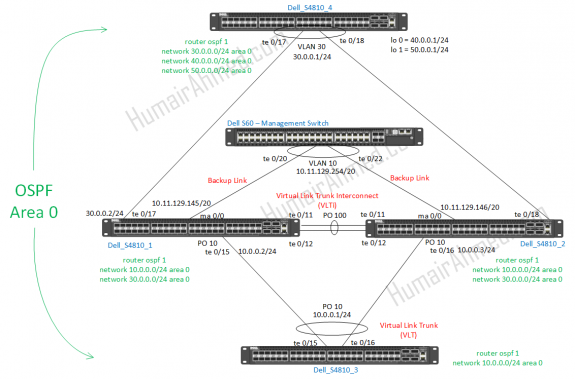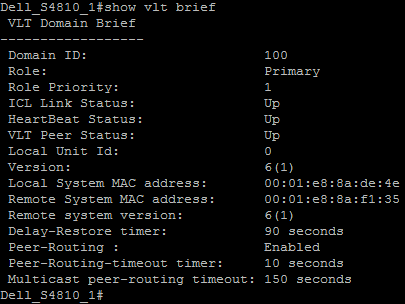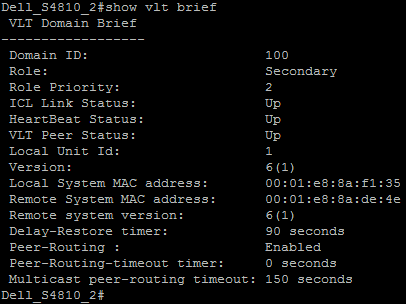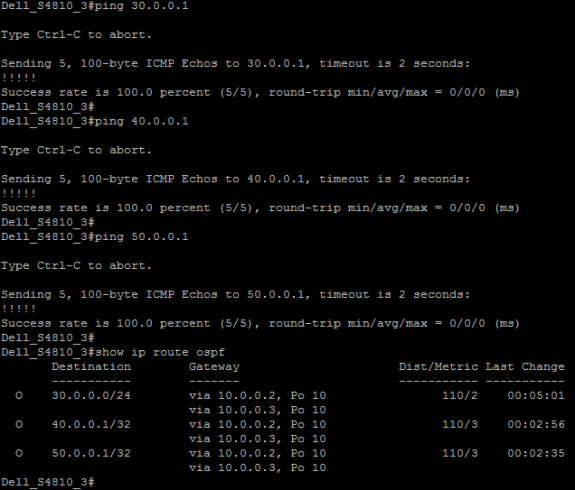Dell Networking recently released enhancements to their VLT multipathing technology in FTOS 9.2 now available on S4810, S4820T, and Z9000. For a quick primer on Dell’s VLT technology read my prior blog post here. The most noticeable enhancement is the support of layer 3 routing protocols over VLT. Additional enhancements include the ability of VLT peers to synchronize ARP entries learned from non-VLT interfaces, support for IPv6, and the ability to synchronize multicast routing tables between peer VLT ports. In this blog, I use 4 x Dell S4810s [FTOS 9.2] and 1 x Dell S60 (for a management switch) [FTOS 8.3.3.9] to demonstrate routed VLT.
Below is the network diagram for this lab.
As you can see VLT is configured on two S4810 switches (‘Dell_S4810_1’ and ‘Dell_S4810_2’) down to a third S4810 switch, ‘Dell_S4810_3’. I have configured OSPF on all four Dell S4810 switches and will demonstrate routing over VLT using OSPF.
Dell_S4810_4 Config:
– enable
– conf
– protocol spanning-tree rstp
– no disable
– bridge-priority 8192
– exit
– interface range tengigabitethernet 0/17 – 18
– switchport
– no shutdown
– exit
– interface vlan 30
– untagged tengigabitethernet 0/17
– untagged tengigabitethernet 0/18
– ip address 30.0.0.1/24
– no shutdown
– exit
– interface loopback 0
– ip address 40.0.0.1/24
– exit
– interface loopback 1
– ip address 50.0.0.1/24
– exit
– router ospf 1
– network 30.0.0.0/24 area 0
– network 40.0.0.0/24 area 0
– network 50.0.0.0/24 area 0
– end
– write
Dell_S4810_1 Config (VLT Peer):
– enable
– conf
– protocol spanning-tree rstp
– no disable
– bridge-priority 0
– exit
– interface managementethernet 0/0
– ip address 10.11.129.145/20
– no shutdown
– exit
– interface tengigabitethernet 0/17
– ip address 30.0.0.2/24
– no shutdown
– exit
– interface range tengigabitethernet 0/11 – 12
– no shutdown
– exit
– interface port-channel 100
– channel-member tengigabitethernet 0/11
– channel-member tengigabitethernet 0/12
– no shutdown
– exit
– vlt domain 100
– back-up destination 10.11.129.146
– peer-link port-channel 100
– primary-priority 1
– unit-id 0
– peer-routing timeout 10
– exit
– interface tengigabitethernet 0/15
– port-channel-protocol LACP
– port-channel 10 mode active
– no shutdown
– exit
– interface port-channel 10
– switchport
– vlt-peer-lag port-channel 10
– no shutdown
– exit
– interface vlan 10
– untagged port-channel 10
– ip address 10.0.0.2/24
– no shutdown
– exit
– router ospf 1
– network 10.0.0.0/24 area 0
– network 30.0.0.0/24 area 0
– end
– write
Dell_S4810_2 Config (VLT Peer):
– enable
– conf
– protocol spanning-tree rstp
– no disable
– bridge-priority 4096
– exit
– interface managementethernet 0/0
– ip address 10.11.129.146/20
– no shutdown
– exit
– interface tengigabitethernet 0/17
– ip address 30.0.0.3/24
– no shutdown
– exit
– interface range tengigabitethernet 0/11 – 12
– no shutdown
– exit
– interface port-channel 100
– channel-member tengigabitethernet 0/11
– channel-member tengigabitethernet 0/12
– no shutdown
– exit
– vlt domain 100
– back-up destination 10.11.129.145
– peer-link port-channel 100
– primary-priority 1
– unit-id 0
– peer-routing timeout 10
– exit
– interface tengigabitethernet 0/16
– port-channel-protocol LACP
– port-channel 10 mode active
– no shutdown
– exit
– interface port-channel 10
– switchport
– vlt-peer-lag port-channel 10
– no shutdown
– exit
– interface vlan 10
– untagged port-channel 10
– ip address 10.0.0.3/24
– no shutdown
– exit
– router ospf 1
– network 10.0.0.0/24 area 0
– network 30.0.0.0/24 area 0
– end
– write
Dell_S4810_3 Config:
– enable
– conf
– protocol spanning-tree rstp
– no disable
– bridge-priority 8192
– exit
– interface range tengigabitethernet 0/15 – 16
– no shutdown
– port-channel-protocol lacp
– port-channel 10 mode active
– exit
– int port-channel 10
– ip address 10.0.0.1/24
– no shutdown
– exit
– router ospf 1
– network 10.0.0.0/24 area 0
– end
– write
Note, the new “peer-routing timeout” command on both VLT peer switches. This is the command that enables VLT routing. The ‘timeout’ value is optional and is set to ‘0’ or no timeout by default. The value is entered in seconds and the maximum value it can be is ‘65535’. When the timer expires, the VLT peer is checked to see if it is available; if the VLT peer is not available, peer-routing is disabled on that peer. Below I show the output of the ‘show vlt brief’ command on both VLT peer switches to confirm VLT is up and running.
You can also see that I created loopback addresses for networks 40.0.0.0/24 and 50.0.0.0/24 on ‘Dell_S4810_4’. I did this so I had more networks to populate the OSPF database with. Below I confirm the routes in the routing table on ‘Dell_S4810_4’. Further below I then confirm that the routes are learned from OSPF and reachable on ‘Dell_S4810_3’ which has the lag connecting up to ‘Dell_S4810_1’ and ‘Dell_S4810_2’ via VLT. Welcome to VLT Routing!








 Twitter
Twitter LinkedIn
LinkedIn Youtube
Youtube RSS
RSS
3 Responses to Dell Networking Extends Multipathing Capabilities with VLT Routing